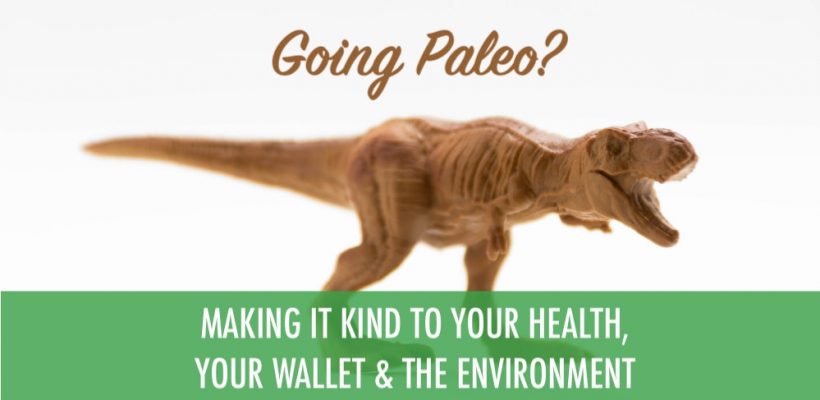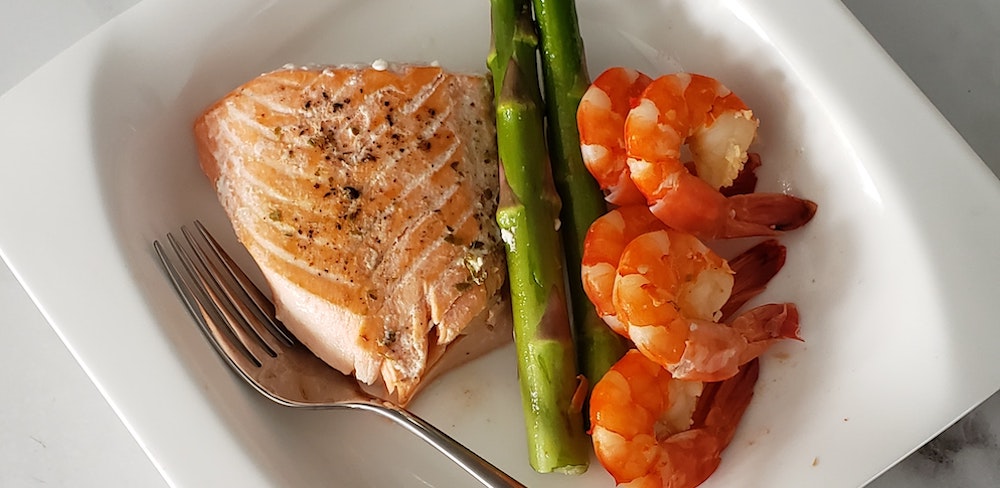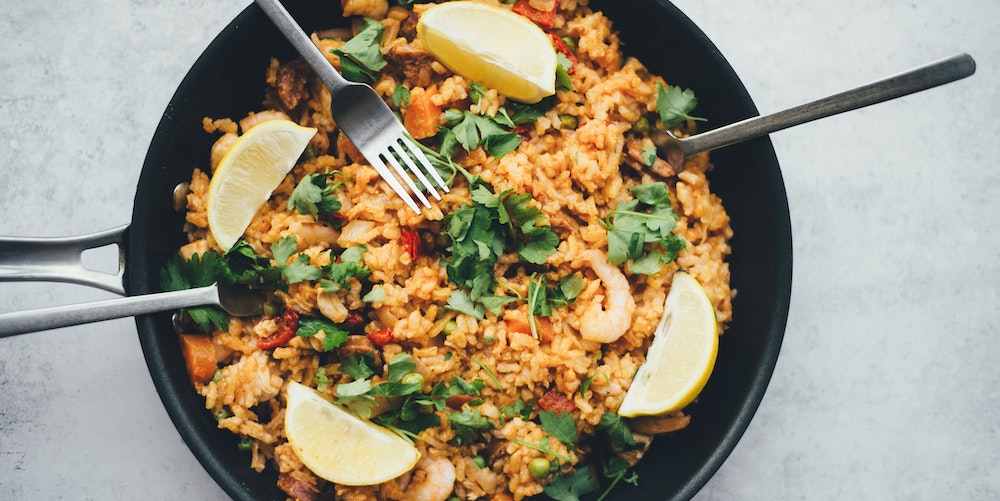
Going Paleo? Make It Kind to Your Health, Your Wallet and the Environment
If you’re considering going paleo and eating like a caveman (or cavewoman) then be prepared for the hidden costs. New research suggests that eating this nostalgic diet in the modern world can be hard on the environment, your pocket and your health.
The Paleo Diet – Is It Just An Expensive Fad Diet?
A few years ago, it was all the rage to be doing it like a caveman. Eating that is. The Paleolithic diet (also known as the Paleo diet, Stone Age diet, or caveman diet) promised health benefits galore, all from eating foods that your ancestors were believed to eat. One of the biggest dietary changes required for this way of eating was the elimination of all grains, pulses, legumes and dairy. For many people, this style of diet led to weight loss, which isn’t surprising considering several categories of food were cut out. But it also had the potential for causing nutrient deficiencies and imbalances, especially in calcium and healthy oils and fats.
So, is the Paleo diet any good for your health and do the numbers ever really stack up? In a new study published in the Science of The Total Environment journal, researchers suggest ‘No’ and conclude that the Paleo diet is more likely to leave a hole in the environment, your wallet AND your health.
“The Paleo Diet can be considered as an expensive and not nutritionally adequate diet with a high carbon footprint”. [1]
Scathing words indeed.
But if you’re feeling pretty flush and the idea of eating meat, fish, berries and veg and avoiding all processed foods is appealing, then how do you keep it healthy? Is it possible to eat a Paleo diet that reaches all the vitamin and mineral nutritional targets and is environmentally friendly too?
Let’s start by taking a look at the Paleo diet to see what you will (or won’t!) have on your plate.
The Paleo Diet – Foods To Eat

The Paleo diet is pretty much a wholefood diet. The aim is to eat the types of foods that your hunter-gatherer ancestors potentially ate. So what sorts of foods were these? Well if you can catch it, pick it or press it then it’s something that would have been on the menu.
Foods to eat on the Paleo diet include:
- fish and seafood
- game
- meat
- vegetables
- fruits
- herbs
- spices
- nuts
- seeds
- fats and oils.
The Paleo Diet – Foods To Avoid

Your ancestors didn’t have access to herds of cattle or food processing factories, so there are huge chunks of the modern diet which won’t make it to your Paleo-diet shopping (or hunting and gathering) list. Foods that are processed, artificial or a grain are typically excluded. There could even be an upside to this as over-consumption of many of the foods below is associated with sub-optimal health.
Foods to exclude on the Paleo diet include:
- highly processed foods
- diet meals
- low-fat foods
- hydrogenated or partially hydrogenated oils and fats
- vegetable oil
- artificial sweeteners
- high-fructose corn syrup
- sugar
- dairy
- grains
- legumes.
The Paleo Diet – Drinks
What might you drink when going Paleo? First on the list is water. In fact if you were to be a strict Paleo, then this would be the extent of your list. Perhaps you could toss a berry or slice of cucumber into your glass if you really wanted to rev things up. However this doesn’t sound particularly appealing or even sustainable in the long term. An extended drinks list would include tea and coffee, to be drunk neat without milk or sugar. Coffee could be made bullet-proof with the addition of coconut oil or grass-fed butter. The occasional glass of wine would also be appropriate. Imagine how many over-ripe fruit and berries would have been eagerly gobbled up back in the day!
Drinks to enjoy when following a Paleo diet:
- water (which can also be flavoured with fruit, lemon or a slice of cucumber)
- herbal tea
- green tea
- black tea
- coffee
- bullet-proof coffee
- wine.
SUMMARY
The Paleo diet is a wholefood diet based on meat, fish, and vegetables in the most natural state. Processed foods, artificial ingredients, grains and legumes are excluded, which includes sugar, many deserts, bread, pasta and sodas.
The Paleo Diet and Your Health

Nutritionally speaking the Paleo diet offers a mix of positives and negative’s.
You’ll eat fewer carbs and sugars…
In terms of composition it’s low in sugars, starchy carbohydrates and includes plenty of fresh veg. Carbohydrates provide around 24.5% of the total energy intake. This is siginificantly lower than current recommendations. In the UK, the government’s Eatwell Guide [2], illustrated by the Eatwell plate, suggests to cover ⅓ of your plate with carbohydrates and an additional ⅓ with vegetables and fruit, which means that more than 50% of your energy intake would come from carbs. At 24.5% your typical carb intake is also lower than the Wellness Solution recommendations. [3] This is an evidence-based, updated version of the Eatwell plate developed by the British Association for Nutrition and Lifestyle Medicine (BANT). Here root veg and whole grains cover only ¼ of the plate, ½ is for leafy greens, salads and other veg. 1 to 2 portions of fruit can be eaten in addition each day.
So on some Paleo diets you’ll eat far fewer carbs (unless you’re consuming a huge volume of fruit and veg). You’ll probably remember the link between carbohydrate intake, blood glucose and insulin levels and your metabolism. In fact it came up as we explored the ketogenic diet, a high-fat/medium-protein/low-carb diet which had the potential for encouraging better weight management. You can read more here in The Beginner’s Guide to a Healthy Ketogenic Diet.
\Your protein intake will increase…
The typical Paleo diet is high in protein (you’ll probably be eating it at every meal). In general, proteins provide around 30% of the total energy intake. Again this is higher than the UK government recommendations where protein-rich foods would cover less than 1/5th of your Eatwell plate. It’s also higher than the BANT Welness Solution Plate which suggests a protein serving that covers ¼ of your plate.
However, a high protein intake isn’t particularly healthy. An excess is associated with an increased risk of osteoporosis, cardiovascular disease and is a poor choice if you have kidney issues [4] Your intake also depends on your level of activity. If you’re sedentary then you’ll only need 0.8 g of protein/ kilogram of bodyweight; whereas if you regularly exercise at an intense effort level, then your intake requirements will increase to around 1.6 g/kg of your body weight.
This is one of the reasons why regular exercise is a feature of a healthy Paleo lifestyle.
You’ll exclude categories of foods…
How is it possible that a diet that is so rich in fresh vegetables and fruit can still have a nutritional hole? Well primarily because it excludes 3 large groups of food – grains, pulses and dairy. There is also the propensity to eat more omega-6 fats and oils – which come from the meat, seeds and nuts you eat. In contrast your omega-3 intake might be low. This may lead to deficiencies, particularly in B vitamins, calcium, and an imbalanced omega 3 : 6 ratio.
If these are of concern to you, then a high-strength multivitamin and a omega oil from fish or algae could be good supplements to take.
SUMMARY
The nutritional composition of the Paleo diet has some positives and negatives. The lower carbohydrate and sugar intake is typically beneficial for health. This is a recurring theme, for example with the ketogenic diet. However Paleo has quite a high protein content and also has the potential for vitamin and mineral deficiencies. Increasing your level of daily activity can increase your protein utilisation and soften the effect of a higher protein intake. A well selected multi and omega oil could be used to fill in the nutritional gaps.
The Paleo Diet and the Enviroment

In their study, a second aim of Cambese-Franco and her team was to evaluate the safety of the Paleo diet on the environment. However when compared with the Mediterranean diet, the Spanish dietary guidelines, and southern European Atlantic diet, it didn’t fare well. The Paleo diet had a higher carbon footprint (5.44kg CO2 / person / day) and a higher water footprint (3499 L / person / day).
So what might you do differently if you were to eat a Paleo diet? The ideal would be to eat organic foods, so if your veg and fruit were also seasonal and grown in the UK, then you’d be miles ahead. Nuts and seeds would pose more of a problem. How many varieties are grown in the UK?
Fish, meat and poultry would pose challenges to varying degrees. Organic, free-range poultry is easy to find; organic, free-range, grass-fed beef can be sourced, but wild-caught fish would come from further afield. The carbon and water footprint may be hard to reduce.
SUMMARY
As stated earlier, Cambese-Franco described the Paleo diet as ‘expensive, nutritionally inadequate, and with a large carbon footprint’ when compared with other types of diet eaten in Spain. Some of this can be mitigated, for example by eating seasonal foods which are grown in the UK. However when following a Paleo diet, without your best efforts, this environmental impact might be difficult to overcome.
***
Transforming the Paleo Diet from Fad to Functional
The Paleo diet offers the opportunity to revisit an older style of eating – one that focuses on whole foods including fish, meat, poultry, nuts, seeds, that oils and vegetables and fruit. It eliminates processed foods and those that are artificial which can have obvious benefits. However, it also cuts out entire food groups – mainly pulses, dairy, and grains. This can lead to weight-loss in the short term, but over the long-term this may not be so good for your health.
It will take some attention to achieve nutritional adequacy, to make sure that your protein intake is not unhealthily high, or that you don’t miss out on key vitamins and minerals including B vitamins, calcium, and essential fats.
There is also the environmental impact, to consider, as this style of eating has a higher water and carbon footprint. However with the right attention and effort it’s possible that this may be reduced, creating a modern-day version of the Paleo diet which is healthier for both you and the environment.
References
[1] Cambeses-Franco et al (2021) Is the Paleo diet safe for health and the environment? [2] NHS (2019) The Eatwell Guide [3] BANT (2018) The Wellness Solution [4] Wu G (2016) Dietary protein intake and human health.Images
Lucas George Wendt, Sam Abtahi, Annie Spratt, Roxanne Desgagnes, Grant Ritchie at Unsplash.com
